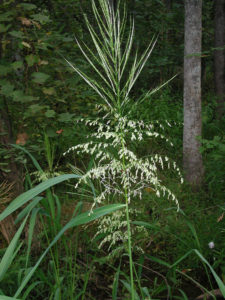| Common Name(s) | Wild Rice | ||||
| Scientific Name | Zizania aquatica | ||||
| Family | Poaceae | ||||
| Location/Vegetative Zone | Shallow water in small lakes and slow-flowing streams | ||||
| Flowering Period | July-September, seeds ripen from September-October | ||||
| Identifying Characteristics | Grows up to 11ft, long leafless stalk with small yellow-white seeds at the top | ||||
Description
- Annual plant
- Grows up to 11ft tall
- Leaves are:
- Lanceolate
- Flat, very thin
- 1 m long, 4 cm wide
- Purple leaf markings
- White to purple flowers
- Flowers tiny and grow on spikelets
- Bloom from July-September
- Produces a dark brown to black seed
- Seeds ripen from September-October
Misc
- Habitat:
- Shallow water in small lakes and streams
- Likes sandy, loamy, or clay soil
- Needs sunlight- cannot grow in shade
- Grows in Eastern North America , New Brunswick to Manitoba, south to Florida and Texas
- Edibility:
- Grain can be harvested
- When the seed is cooked, it can be used as a cereal
- Was a staple food source to the Native American Indians and the Chinese
- Has a high nutritional value and great taste
- High in protein, amino acids, and dietary fiber, and low in fat
- Can also be ground into meal and used to make bread
- In China, the stem is used as a vegetable
- Wild rice seeds can be infected by the highly toxic fungus ergot, which is dangerous if eaten. Infected grains have pink or purplish blotches.
2,525 total views, 1 views today

